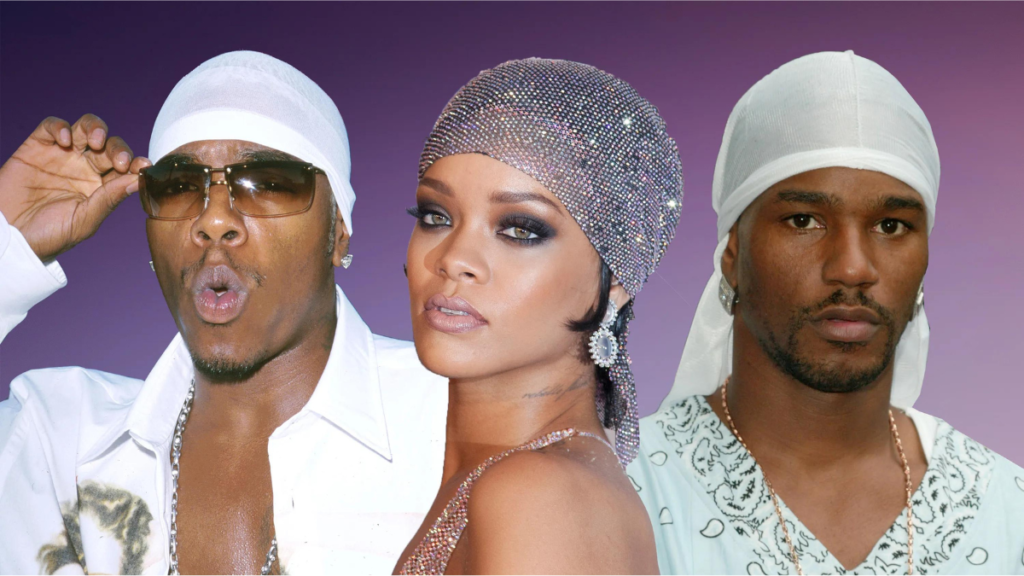The durag, originally designed to protect hairstyles, has evolved into a symbol of style, identity, and cultural expression. Originating in the early 19th century, it served practical purposes for African American individuals with textured hair. However, it remained relatively niche in the 20th century, primarily worn at home or in private spaces.
In the late 20th and early 21st centuries, the durag experienced a resurgence in popular culture, transitioning from a utilitarian item to a fashion accessory embraced by individuals from various backgrounds. Hip-hop culture influenced the durag’s mainstream acceptance, with rappers like Jay-Z, 50 Cent, and Lil Wayne featuring it in their music videos and public appearances.
The durag has become a powerful symbol of cultural pride, celebrating diverse hairstyles and textures, challenging Eurocentric beauty standards that often marginalize natural hair. High fashion brands like Gucci, Louis Vuitton, and Versace have incorporated durags into their collections, while streetwear brands have embraced the durag as a staple item.
Despite its growing popularity, the durag has faced criticism for appropriating and commodifying an item deeply rooted in Black culture. Supporters argue that its popularity has created an opportunity for cultural exchange and understanding, fostering a more inclusive society.
The Origin and History of the Durag
The durag’s roots can be traced back to the early 19th century, with its origins intertwined with the experiences of people of African descent in the United States. Initially known as a “doorag” or “head rag,” it served practical purposes for individuals with textured hair. The durag gained popularity during the era of slavery as a means of maintaining hairstyles, protecting textured hair from environmental factors, and preserving intricate braids.
Throughout the 20th century, the durag continued to be a staple within African American communities, but it remained relatively niche. It was primarily worn at home or in private spaces, and its mainstream visibility was limited.
Resurgence in Pop Culture
In the late 20th and early 21st centuries, the durag experienced a resurgence in popularity, transitioning from a utilitarian item to a fashion accessory embraced by individuals from various backgrounds. This shift can be attributed to the influence of hip-hop culture, where artists and influencers began incorporating durags into their public personas.
Rappers like Jay-Z, 50 Cent, and Lil Wayne prominently featured durags in their music videos and public appearances, contributing to the mainstream acceptance of this once overlooked accessory. The durag became a symbol of authenticity, resilience, and a connection to cultural roots.
Beyond its functional purposes, the durag became a canvas for self-expression. Durags started featuring an array of colors, patterns, and materials, reflecting the wearer’s personality and style. This evolution marked a departure from the durag’s historical association with necessity, transforming it into a deliberate fashion choice.
Durag as a Symbol of Cultural Pride
The durag has transcended its initial purpose as a hair accessory and has become a powerful symbol of cultural pride. It represents a celebration of diverse hairstyles and textures, challenging Eurocentric beauty standards that have often marginalized natural hair within mainstream culture.
Individuals who wear durags today often do so with a sense of pride in their heritage and a desire to challenge stereotypes. It serves as a visual assertion of identity and a rejection of societal pressures to conform to a singular standard of beauty.
Durags in Fashion: Runway to Streetwear
As the durag gained popularity in popular culture, it also found its way into the world of high fashion. Luxury brands began incorporating durags into their runway shows and collections, elevating this once humble accessory to a status symbol. Designers like Gucci, Louis Vuitton, and Versace showcased durags in their fashion lines, emphasizing their recognition of the durag’s cultural significance.
Simultaneously, streetwear brands embraced the durag as a staple item. Its affordability and versatility made it accessible to a broad audience, further fueling its popularity. From vibrant patterns to sleek, monochromatic designs, durags became a dynamic accessory that could complement various fashion styles.
Durag Challenges and Controversies
Despite its growing popularity, the durag has not been immune to controversy. Some critics argue that the mainstream adoption of the durag by non-Black individuals appropriates and commodifies an item deeply rooted in Black culture. The debate surrounding cultural appropriation raises questions about who gets to define and profit from certain cultural symbols.
Conversely, supporters of the durag’s widespread adoption argue that its popularity has created an opportunity for cultural exchange and understanding. They contend that appreciating and embracing diverse styles fosters a more inclusive and accepting society.
Conclusion
The durag’s journey from a practical hair accessory to a cultural phenomenon is a testament to its resilience and significance within the Black community. As a symbol of pride, resistance, and self-expression, the durag has transcended its humble origins to become a powerful element in the ever-evolving landscape of fashion and cultural identity.
While debates about cultural appropriation persist, there is no denying the impact the durag has had on shaping conversations around beauty standards, identity, and representation. As we continue to witness the evolution of fashion and cultural expression, the durag stands as a symbol of resilience, breaking boundaries, and embracing authenticity.







